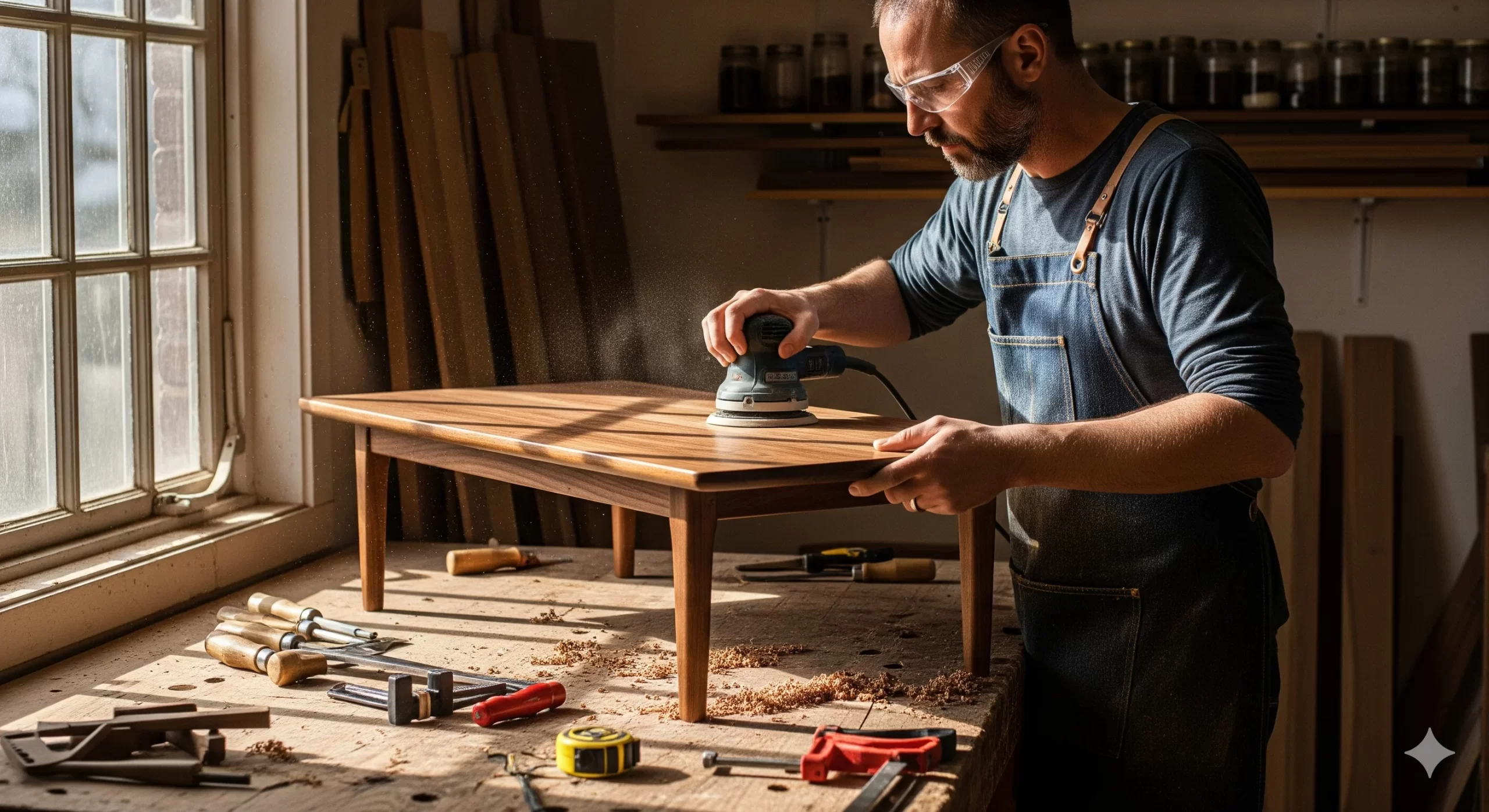
Use Simple Shapes for Your First Project
When starting out, it’s best to choose woodworking plans that feature simple geometric shapes. Here are some ideas:
- Rectangular Table: The most common shape, which is perfect for any living room.
- Round Table: Ideal for small spaces, these tables are easy to build and stylish.
- Square Table: Offers a modern touch, suitable for both traditional and contemporary decor.
Materials You Might Need
Choosing the right materials is crucial for your woodworking project. Here’s a basic list of materials you may want to consider:
- Wood: Pine, oak, or plywood are excellent choices for beginners.
- Screws: Ensure you use wood screws that are strong enough to hold your table together.
- Wood Glue: A good quality wood glue can enhance the stability of your project.
- Finish: Choose a stain or varnish to give your table a polished look.
Step-by-Step Building Process
Following organized steps can simplify the woodworking process. Here’s a suggested outline for building a basic coffee table:
- Plan Your Design: Sketch an outline of your table for clarity.
- Measure and Cut the Wood: Use a saw to cut your wood to the designated lengths.
- Assembly: Start by assembling the tabletop first, followed by the legs.
- Sanding: Sand the surface to make it smooth to the touch.
- Finishing: Apply your chosen stain or varnish to protect the wood and enhance appearance.
Incorporate Storage Solutions
Add a unique twist to your coffee table by incorporating storage. Here are a few imaginative ideas:
- Drawer Storage: Include drawers in your design to store magazines or remote controls.
- Shelf Space: Create a bottom shelf to showcase books or decorative items.
- Lift-Top Design: A lift-top table provides hidden storage and can double as a workspace.
Online Resources and Plans
Finding comprehensive woodworking plans can greatly enhance your project. Here are some websites that offer free and paid Coffee Table Woodworking Plans:
- Wood Magazine: A well-established source for woodworking plans.
- Instructables: Offers creative and step-by-step guides for DIY coffee tables.
- Ana White: A popular site dedicated to free plans for furniture projects.
Safety First
Before you start any woodworking project, make sure to prioritize safety. Always wear protective gear such as goggles and a mask to protect against sawdust and debris. Ensure your workspace is well-organized and free from distractions.
Remember, woodworking requires patience and practice. Start with small projects and gradually challenge yourself with more complex designs. The coffee table project not only beautifies your space but also provides a sense of accomplishment when you see your handiwork.
Essential Tools and Materials for Crafting Coffee Tables
Crafting a beautiful coffee table can be an enjoyable and rewarding experience. To create a stunning piece that suits your home, you’ll need several essential tools and materials. Understanding what is required will help you navigate the woodworking process with ease.
Essential Tools for Coffee Table Woodworking
Having the right tools can make all the difference in your woodworking project. Here are some must-have tools for crafting coffee tables:
- Table Saw: This is essential for making accurate, straight cuts on your wood. A table saw allows you to cut larger pieces efficiently and is a staple in any woodworker’s shop.
- Miter Saw: This tool is perfect for making precise crosscuts and miters, especially useful when creating angled edges.
- Drill and Drill Bits: A power drill is necessary for creating holes for screws and dowels. Make sure to have a variety of bits for different sizes of holes.
- Sander: Smooth out any rough surfaces of your coffee table with an orbital or belt sander. Sanding is critical for achieving a polished look.
- Clamps: These are essential for holding pieces together while the glue dries. Invest in a variety of sizes to accommodate different joints.
- Router: A router can help you add edge profiles or grooves for aesthetic details. This is optional but can elevate your design.
- Measuring Tape and Square: Accurate measurements are crucial for any woodworking project. A measuring tape and square ensure your cuts are precise.
Materials Needed for Building Coffee Tables
Once you’ve gathered your tools, it’s time to consider the materials. The type of wood you choose will greatly affect the final appearance and durability of your coffee table. Here are some commonly used materials:
- Wood: Hardwoods like oak, walnut, and maple are excellent choices due to their durability and beauty. Softwoods like pine are also options but may be less durable.
- Wood Glue: A strong adhesive is necessary for ensuring your joints are secure. Choose a type that dries clear for a neater finish.
- Wood Stain and Finish: To enhance the wood’s natural beauty, you’ll need stain and sealer. Options vary from oil-based to water-based styles.
- Hardware: Include screws, brackets, or hinges depending on your design. Ensure you select quality pieces that match your wood type.
Choosing Your Wood Type
The choice of wood can significantly impact the look and feel of your coffee table. Below is a comparison of some popular wood types that you might consider:
| Wood Type | Durability | Cost |
|---|---|---|
| Oak | High | Medium |
| Walnut | High | High |
| Pine | Low to Medium | Low |
| Maple | Medium to High | Medium |
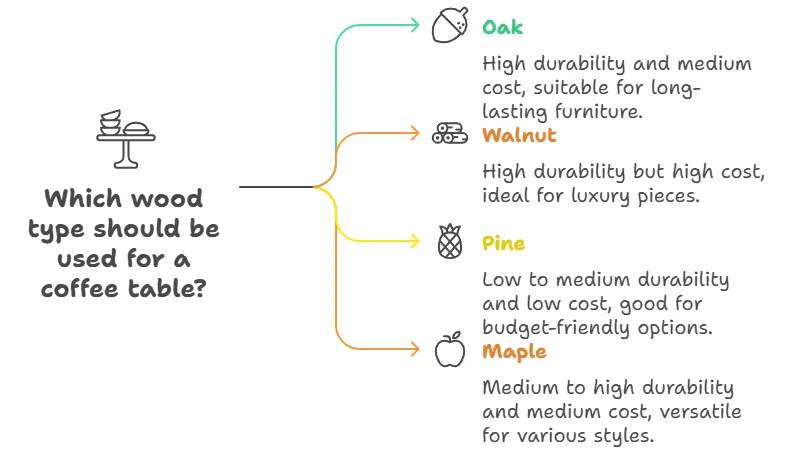
Choosing the right wood will depend on your budget and the style you want to achieve. Consider visiting Wood Magazine for more insights into selecting the right materials.
Final Notes on Preparing for Your Project
As you prepare to craft your coffee table, make sure to gather all your tools and materials ahead of time. Organizing your workspace can improve efficiency and keep your project on track. Don’t forget to wear appropriate safety gear, such as goggles and gloves, to protect yourself while working.
With the right tools and materials, crafting your coffee table will not only enhance your woodworking skills but also provide a functional piece of art for your living space. Check out Popular Woodworking for detailed plans and inspiration.
By taking the time to gather everything you need, you’ll ensure your woodworking journey is a positive experience, culminating in a beautiful coffee table fit for your home.
Creative Design Ideas for Custom Coffee Tables
Creating a custom coffee table can transform your living space and serve as a functional centerpiece. With various styles, materials, and sizes available, you have the flexibility to design a piece that perfectly fits your home. Here are some imaginative ideas to inspire your next woodworking project.
Unique Materials to Use
Consider incorporating unconventional materials for a striking look. Here are some suggestions:
- Reclaimed Wood: Old barn wood or pallets can add character and history.
- Glass: A glass top can make a space feel airy while showcasing an intricate base.
- Metal: Mixing wood with metal legs creates a modern industrial vibe.
- Concrete: A concrete surface provides a robust, contemporary aesthetic.
Design Styles to Explore
Your coffee table design can reflect your style while fitting seamlessly into your decor. Some popular options include:
- Rustic: Chunky, untreated wood with visible knots and a natural finish can evoke a cozy feel.
- Mid-Century Modern: Clean lines, tapered legs, and a simple finish characterize this timeless look.
- Minimalist: Choose a sleek, uncluttered design that emphasizes functionality.
- Bohemian: Use bold colors, patterns, and mixed materials for an eclectic effect.
Innovative Shapes and Sizes
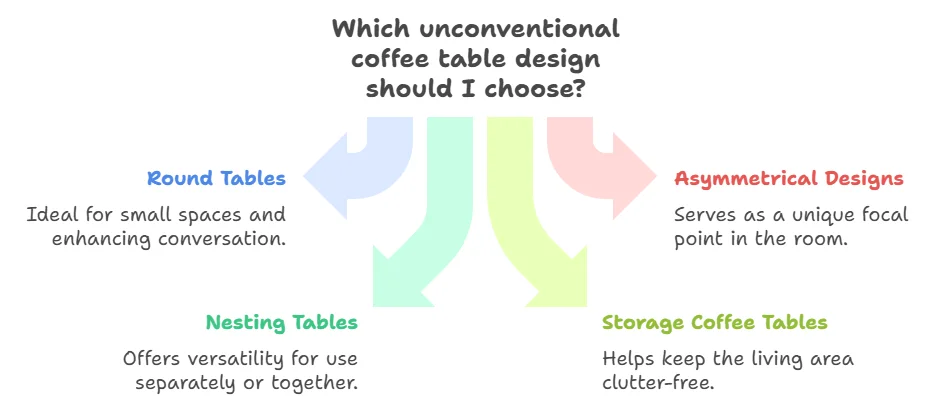
Don’t be afraid to think outside the box when it comes to the shape and size of your coffee table. Consider these unconventional options:
- Round Tables: These are great for smaller spaces and encourage conversation.
- Asymmetrical Designs: A unique tabletop shape can serve as a stunning focal point.
- Nesting Tables: These offer versatility, allowing you to use them separately or together.
- Storage Coffee Tables: Incorporate drawers or shelves to keep your living area clutter-free.
Custom Features to Add Flair
Enhance your coffee table with features that add functionality and visual interest. Here are some ideas:
- Hidden Compartments: A lift-top design can reveal a hidden space for magazines or remote controls.
- Integrated Lighting: Adding LED lights can create an atmospheric glow.
- Artistic Inlays: Use different wood varieties or materials to create beautiful patterns or designs.
- Wine Storage: Incorporate space for your favorite bottles to impress guests during gatherings.
Inspiration from Skilled Craftsmen
For those looking for step-by-step instructions, there are incredible resources online that provide detailed woodworking plans. Websites such as Wood Magazine and Ana White offer a plethora of design ideas and plans to get you started.
Finding Your Personal Style
Ultimately, your coffee table should reflect your personality and lifestyle. Experiment with different designs, colors, and finishes. Whether you’re aiming for a cozy vibe with warm woods or a sleek, modern look with glass and metal, let your imagination guide you.
Working With Woodworking Plans
When working on your coffee table project, having a well-structured woodworking plan can significantly ease the process. Consider these aspects:
| Aspect | Details |
|---|---|
| Measurements | Ensure you have precise dimensions to fit your space. |
| Materials List | Document all required materials to ensure a smooth assembly. |
| Tools Needed | Gather any tools necessary for cutting, assembling, and finishing. |
By utilizing these strategies and concepts, you can create a custom coffee table tailored to your home. For more tips and ideas, check out resources like Family Handyman and Instructables, where you can find excellent plans and community inspiration.
Tips for Choosing the Right Wood for Your Coffee Table Project
Creating a coffee table can be a rewarding project, but selecting the right wood is crucial for achieving the best results. Different types of wood offer unique appearances, durability levels, and workability. Understanding these factors will help you make an informed decision for your coffee table.
Consider the Aesthetic
When choosing wood for your coffee table, start with the look you want to achieve. Wood types come in various grain patterns and colors, so consider the style of your room:
- Dark woods like walnut or mahogany can lend a formal, elegant touch.
- Light woods such as maple or birch are excellent for achieving a modern, airy feeling.
- Reclaimed wood offers a rustic charm, adding character to your design.
Knowing the overall aesthetic you aim for will guide your selection process, ensuring that the wood complements your existing decor.
Durability Matters
Your coffee table will see a lot of use, so choose a wood that can withstand daily wear:
- Hardwoods such as oak, cherry, and hickory are highly durable and resist dents.
- Softwoods like pine and cedar are easier to work with but may be less durable in high-traffic areas.
Consider your lifestyle: if you have young children or pets, durability should be a top priority.
Workability and Tools
The skills and tools you have will influence your wood choice:
- If you’re new to woodworking, softer woods like pine are easier to cut and sand.
- Hardwoods require sharper tools and more effort, but they yield a more robust finish.
Assess your tool collection and expertise level when selecting wood to ensure a successful outcome.
Cost Considerations
Budget is always a factor in any woodworking project. Different woods come with varying price tags:
| Wood Type | Average Cost per Board Foot |
|---|---|
| Pine | $2 – $4 |
| Maple | $4 – $8 |
| Oak | $6 – $10 |
| Walnut | $10 – $15 |
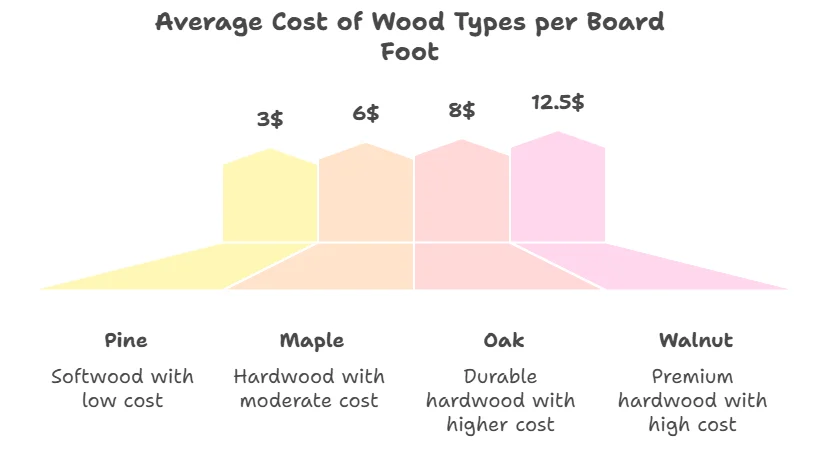
Evaluate your budget to ensure you can afford the wood that meets your aesthetic and functional needs.
Environmental Considerations
When selecting wood, consider the environmental impact:
- Sustainable Sources: Choose wood from managed forests or certified sources to minimize impact.
- Reclaimed Wood: Utilizing reclaimed wood not only provides unique character but also reduces waste.
Look for eco-friendly suppliers and practices to ensure that your coffee table project aligns with your values.
Finish and Maintenance
Think about how you want your coffee table to look after it’s built. The type of finish can alter the color and sheen of the wood:
- Clear finishes enhance the natural beauty of the wood.
- Stains allow for color adjustments without hiding the grain.
- Paint offers complete color customization but covers the wood’s natural character.
Understand the maintenance required for the wood you choose to keep your coffee table looking its best for years to come.
The selection of wood for your coffee table is vital to the success of your project. By considering style, durability, workability, cost, environmental concerns, and finishing options, you can create a beautiful, functional piece that fits seamlessly into your home.
Techniques to Enhance the Durability of Your Coffee Table Design
Creating a sturdy and beautiful coffee table goes beyond just drawing up plans and cutting wood. To ensure your coffee table withstands the test of time, you’ll want to employ several techniques that enhance both its durability and aesthetic appeal. When you invest time in these methods, not only do you end up with a piece that can handle daily wear and tear, but you also create something you’ll be proud to display in your living room for years.
Choosing the Right Materials
Selecting high-quality materials is the first step to achieving a durable coffee table. Pay attention to the different wood types available:
- Hardwoods: Woods like oak, maple, and walnut are known for their strength and resistance to damage. They hold up well against scratches and dents.
- Softwoods: While more readily available and easier to work with, softwoods like pine may require additional treatments to enhance their durability.
- Plywood: This can be a cost-effective alternative if layered correctly, providing stability and strength when designed properly.
Impeccable Joinery Techniques
The way you join pieces of wood together can greatly affect the strength of your coffee table. Here are some effective joinery techniques to consider:
- Dado Joints: These are effective for joining shelves or any internal support within the coffee table.
- Miter Joints: These are great for creating an attractive corner without visible end grain.
- Mortise and Tenon: This time-tested technique provides incredible strength for leg connections, ensuring your table can support weight and usage.
Finish and Protective Measures
A proper finish not only enhances the appearance of your coffee table but also protects it from damage. Consider the following options:
- Polyurethane: This synthetic finish offers a durable barrier against moisture and scratches, perfect for everyday use.
- Lacquer: Known for its quick-drying properties, lacquer can also provide a soft sheen that complements wood grain beautifully.
- Natural Oils: While they may require more frequent application, natural oils like tung or linseed provide a warm, natural finish and enhance wood grain.
Reinforcement Techniques
In addition to natural strength from good materials and joinery, you can reinforce your coffee table’s structure:
- Cross Bracing: Adding diagonal braces can prevent wobbling and increase stability, especially for larger tables.
- Leg Levelers: These adjustable feet can stabilize your table on uneven floors, ensuring it remains steady.
- Support Rails: Installing support rails beneath tabletops can share the weight load and keep the surface from warping over time.
Preventive Care and Maintenance
To keep your coffee table looking its best and functioning well, cultivate a habit of regular maintenance:
- Cleaning: Use a damp cloth for dusting and avoid harsh chemicals that can wear down finishes.
- Reapplication of Finishes: If using oils or waxes, plan to reapply these regularly to maintain a protective barrier.
- Coasters and Placemats: Encourage guests to use coasters and placemats to prevent heat rings and scratches.
By focusing on quality materials, craftsmanship, protective finishes, reinforcements, and maintenance habits, you can create or restore a coffee table that not only looks magnificent but also serves its purpose for years to come. For more detailed woodworking plans and guides, check out resources like Wood Magazine and Rockler Woodworking and Hardware, which offer a wealth of information for enthusiasts at all skill levels.
| Material | Durability Rating | Best Use |
|---|---|---|
| Oak | High | Tables exposed to heavy use |
| Pine | Medium | Rustic, low-traffic areas |
| Plywood | Variable | Cost-effective builds, depending on layers |
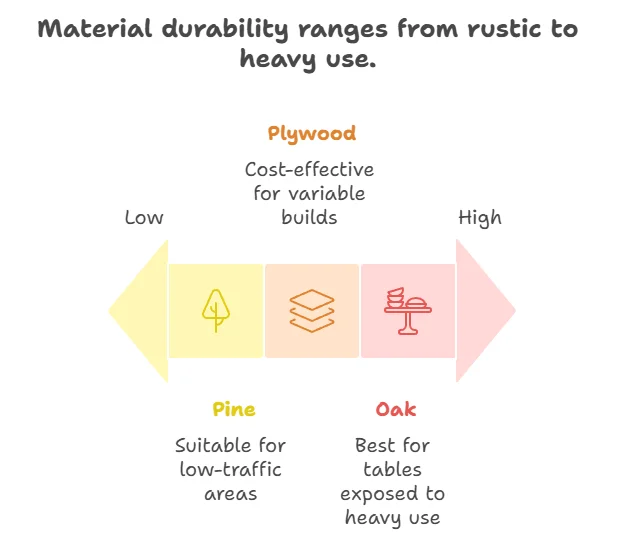
Enhancing the durability of your coffee table is a rewarding endeavor. With thoughtful planning and execution, you can create a piece that not only fits your style but also withstands the rigors of daily life.
Conclusion
Crafting your own coffee table can be a rewarding and fulfilling project, whether you’re a beginner or have some experience in woodworking. By exploring innovative coffee table tailored for beginners, you can find designs that are not only functional but also easy to follow. The right tools and materials are crucial to bringing your vision to life; investing in quality equipment ensures a smoother building process and better results overall.
Additionally, the creative design ideas discussed provide inspiration for creating a coffee table that complements your home. From sleek modern styles to rustic charm, your coffee table can be a true reflection of your personal taste. Choosing the right wood enhances not just aesthetic appeal but also the structural integrity of your piece. Understanding different wood types will empower you to make informed decisions that align with your design goals.
Moreover, incorporating techniques to enhance durability can significantly extend the life of your coffee table. By applying finishes, understanding joinery methods, and maintaining your piece, you can ensure it remains a centerpiece in your living space for years to come. The journey of building a coffee table is not only about the end product but also about honing your skills and spending time on a fulfilling creative endeavor. So gather your tools, plan your design, and enjoy the crafting experience as you create a unique coffee table that truly feels like home. Happy woodworking!